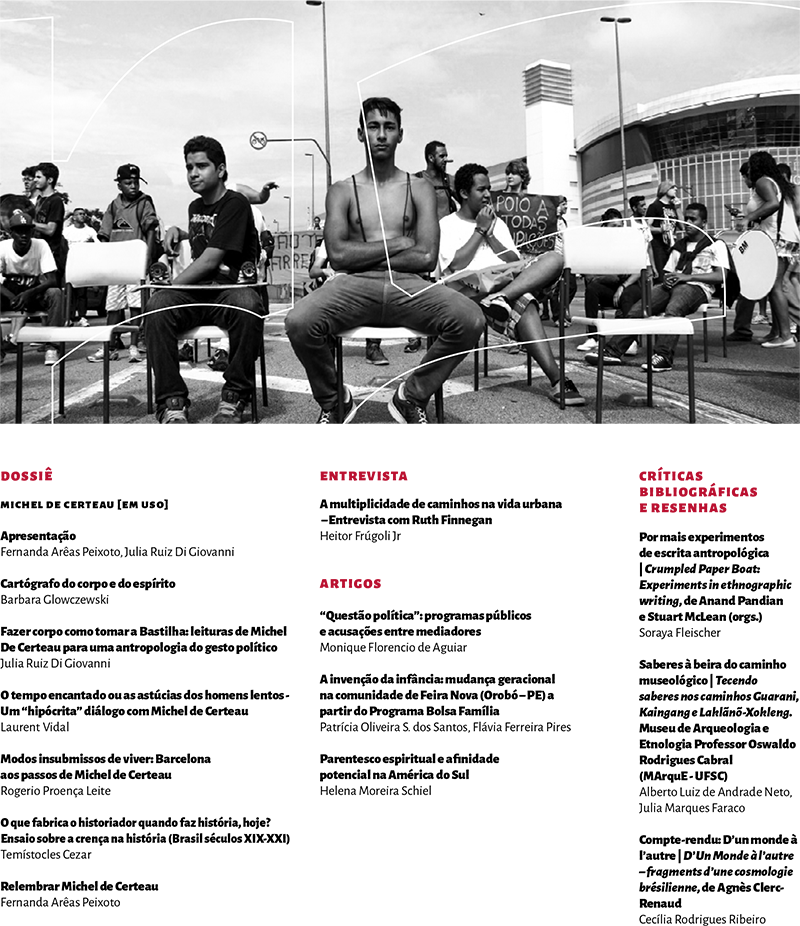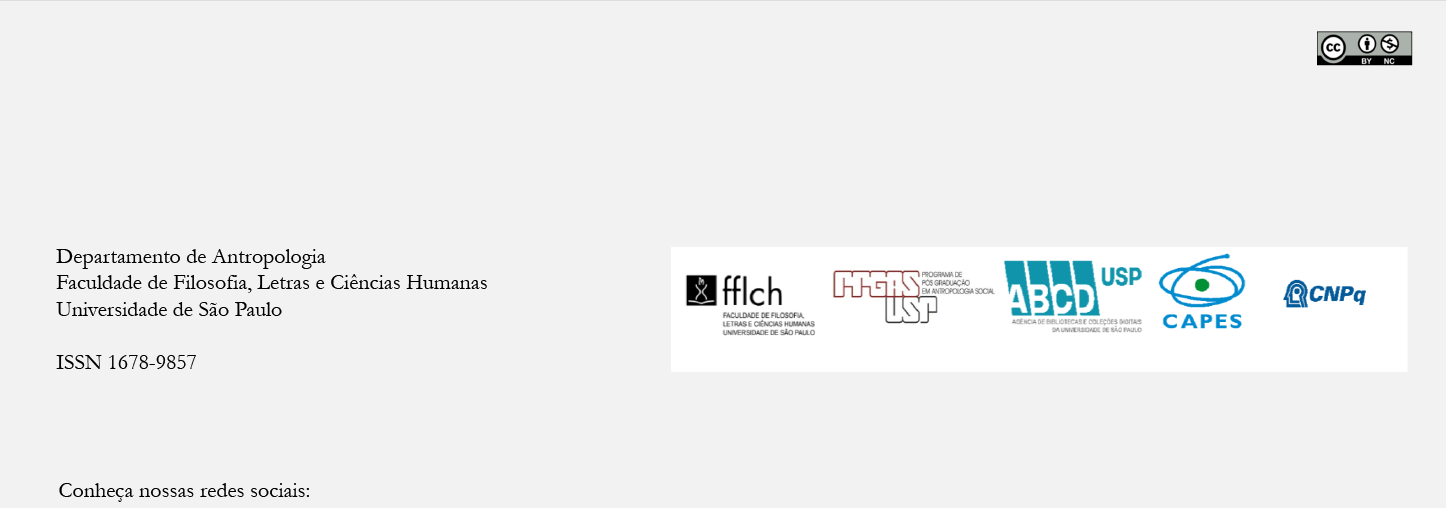Spiritual Kinship and Potential Affinity in South America
DOI:
https://doi.org/10.11606/2179-0892.ra.2018.148952Keywords:
Kinship, Potential Affinity, Godparenthood, PoliticsAbstract
By the colonial encounter, two kinds of institutionalized relations (Christian godparenthood and Amerindian potential affinity) have shown so much similitude that they could be translated in each other. Departing from an approach to Salvatore D’Onofrio’s suggestion of a “spiritual kinship atom”, I want to suggest that the two institutions evoke the same kind of sociological framework. More than the substitution of traditional kinship, I believe that spiritual kinship has a relation of superposition and a kind of overcome to family ties. I advance the hypothesis that this kind of institutionalized relation would be at the basis of every political relation.
Downloads
References
ALAND, Kurt. 1963. Did the Early Church Baptize Infants? (trad. G.R. Beasley-Murray). Philadelphia, The Westminster Press.
CARNEIRO DA CUNHA, Manuela. 1978. Os mortos e os outros. Uma análise do sistema funerário e da noção de pessoa entre os índios krahó. São Paulo, Hucitec.
CAVALCANTI-SCHIEL, Ricardo. 2005. Da relutância selvagem do pensamento. Memória social nos Andes meridionais. Rio de Janeiro, tese de doutorado, Museu Nacional/ UFRJ.
COSTA, Luis. 2013. “Alimentação e comensalidade entre os Kanamari da Amazônia Ocidental”. Mana, 19 (3): 473-504.
DELANEY, Carol. 1986. “The Meaning of Paternity and the Virgin Birth
Debate”. Man. New Series, v. 21, n. 3: 494-513.
DIETSCHY, Hans. 1960. “Note à propos des Danses des Carajá. ‘Pas de deux’, Amitié formelle et proibition de l’inceste”. Bulletin de la Société Suisse des Américanistes, Genebra, 19: 1-15.
DIETSCHY, Hans. 1963. “Le Système de parenté et la structure sociale des indiens Carajá”. Actes du VIe Congrès International des Sciences Anthropologique et Ethnologiques, Paris, Musée de l’Homme, tomo II, v. 1: 43-47.
FAUSTO, Carlos. 2008. “Donos demais. Maestria e domínio na Amazônia”. Mana, 14 (2): 329-366.
GIRALDIN, Odair. 2011. “Creating Affinity. Formal Friendship and Matrimonial Alliances among the Jê People and Apinajé Case”. Vibrant, v. 8, n. 2: 403-426.
GONÇALVES, José Reginaldo Santos. 1981. A luta pela identidade social: o caso das relações entre índios e brancos no Brasil Central. Rio de Janeiro, dissertação de mestrado, Museu Nacional/UFRJ.
GOW, Peter. 1991. Of Mixed Blood. Kinship and History in Peruvian Amazonia. Oxford, Claredon Press.
GOW, Peter. 1997. “Parentesco como consciência humana: o caso dos Piro”. Mana, 3 (2): 39-65.
GUDEMAN, Stephen. 1972. “The Compadrazgo as a Reflection of the Natural and Spiritual Person” Proceedings of the Royal Anthropological Institute, 1971, Londres: 45-71.
GOW, Peter. 1975. “Spiritual Relationships and Selecting a Godparent”. Man New series, Londres, v. 10, n. 2: 221-237.
LANNA, Marcos. 1996. A dívida divina. Troca e patronagem no Nordeste Brasileiro. Campinas, Ed. Unicamp.
LANNA, Marcos. 2009. “A estrutura sacrificial do compadrio: uma ontologia da desigualdade?”. Ciências Sociais Unisinos , São Leopoldo, 45 (1): 5-15.
LEA, Vanessa R. 1993. “Casas e casas Mebengokre (Jê)”. In VIVEIROS DE CASTRO, Eduardo e CARNEIRO DA CUNHA, Manuela (orgs.). Amazônia: etnologia e história indígena. São Paulo, NHII-USP/Fapesp, pp. 265-282.
LEA, Vanessa R. 2012. Riquezas intangíveis de pessoas partíveis. Os Mebengôkre (Kayapó) do Brasil Central. São Paulo, EdUSP.
LEACH, Edmund. 1966. “Virgin Birth”. Proceedings of the Royal Anthropological Institute of Great Britain and Ireland, Londres, issue 1966: 39-49.
LÉVI-STRAUSS, Claude. 1943. “The Social Use of Kinship Terms among Brazilian Indians”. American Anthropologist , New Series, v. 45: 398-409.
LÉVI-STRAUSS, Claude. 1949. Les Structures Élementaires de la parente. Paris, Presses Universitaires de France: IX-XIV.
LÉVI-STRAUSS, Claude. 1958. Anthropologie structurale. Paris, Plon.
LÉVI-STRAUSS, Claude. 1973. Anthropologie structurale deux. Paris, Plon.
LOPES DA SILVA, Aracy. 1986 Nomes e amigos: da prática xavante a uma reflexão sobre os Jê. São Paulo, tese de doutorado, Universidade de São Paulo.
NUTINI, Hugo G. e BELL, Betty Louise. 1989. Parentesco ritual: estructura y evolución histórica en la Tlaxcala rural. México, Editora Fondo de Cultura Económico.
PÉTESCH, Nathalie. 2000. La Pirogue de sable. Pérénité cosmique et mutation sociale chezles karajá du Brésil central. Louvain/Paris, Peeters/Selaf.
RADCLIFFE-BROWN, Alfred Reginald. 2013. “O irmão da mãe na África do Sul”. In Estrutura e função na sociedade primitiva. Petrópolis, Vozes, pp. 21-34.
RAVICZ, Robert. 1967. “Compadrinazgo”. In WAUCHOPE, Robert (org.). Handbook of Middle American Indians. Austin, University of Texas Press, pp. 238-252.
RIVIÈRE, Peter. 1974. “The Couvade: A Problem Reborn”. Man, 9 (3): 423-435.
RODRIGUES, Patrícia de Mendonça. 1993. O Povo do Meio. Tempo, cosmo e gênero entre os Javaé da Ilha do Bananal. Brasília, dissertação de mestrado, UnB.
SAHLINS, Marshall. 2008. “The Stranger-King or, Elementary Forms of the Political Life”. Indonesia and the Malay World, Routledge, Taylor & Francis, Londres, 36 (105): 177-199.
SANTOS-GRANERO, Fernando. 2007. “Of Fear and Friendship. Amazonian Sociality beyond Kinship and Affinity”. Journal of the Royal Anthropological Institute (N.S.), 13: 1-18.
STRATHERN, Marilyn. 1988. The Gender of the Gift. Berkeley, University of California Press.
“Necessidade de pais necessidade de mães”. Estudos Feministas, Florianópolis, v. 3, n. 2: 303-329.
TORAL, André. 1992. Cosmologia e sociedade karajá. Rio de Janeiro, dissertação de mestrado, Museu Nacional/UFRJ.
VIVEIROS DE CASTRO, Eduardo. 2002. “O problema da afinidade na Amazônia”. In A inconstância da alma selvagem. São Paulo, Cosac & Naify, pp. 87-180.
Downloads
Published
Issue
Section
License
Copyright (c) 2018 Revista de Antropologia

This work is licensed under a Creative Commons Attribution 4.0 International License.
Authors who intend to publish in this journal must agree with the following terms:
- a) Authors retain copyright and grant the journal the right of first publication. The work is simultaneously licensed under the Creative Commons Attribution License, which allows the work to be shared as long as the author and the initial publication in this journal are appropriately credited.
- b) Authors are authorized to sign additional contracts for non-exclusive distribution of the version of the work published in this journal (e.g., to publish it as a book chapter), as long as the author and the initial publication in this journal are appropriately credited.
- c) Authors are allowed and encouraged to publish and distribute their work online (e.g. on their personal webpage) after the editorial process, for this can generate productive changes as well as increase the impact and citation of the work. See The Effect of Open Access Publications.




